
 |
|
|
#1 |
|
Member
Join Date: Dec 2004
Location: Oahu, Hawaii
Posts: 166
|
Mabuhay Y'all! I find my self once again in the Philippines after a long absence this time with an agenda in mind. To acquire some pieces that I should have got the last time I was here.
Let me pause right here and mention that I FINALLY got the opportunity to meet with Ian. Thrilled and awed are the first two words that come to mind followed closely by appreciate and gratitude. He was kind enough to spend the majority of a day walking me around to all his known "contacts" and more than that he generously shared his in-depth knowledge of Philippine culture and weapons. I will be eternally grateful. Might I add that he's "A DAMN fine looking young man" With his introductions (and the Philippines is nothing if not a nation based on personal relationships) I was able to pick up this kris which I daily am forced to pull from its tagub and slice the air with. Nothing tells you more about a blade than cleaning it. While if Cato's book holds true, this is a Maranao kris blade (elephant mouth shape and position)and probably a fighting version of a datu kris (straight blade and hilt shape), I feel the blade is quite a bit older than the dress. I didn't think that originally. The metal was quite tarnished and required hours to clean, the wood has a deep patina that is quite gorgeous in person and the ivory pommel had some kind of lacquer like bulid up that I was not entirely able to remove (and truthfully did not want to entirely erase). The blade itself was black, with active rust around the asang-asang. After cleaning however I noted two things, the dress although extremely tarnished shows none of the bangs and dings of use and the blade has been reset using what looks like Blue gasket seal. However contrary to that the silver chasing has been worn almost off on the underside of the hilt which you would expect of an older piece and some of the copper wire bands have loosened with age so I am of two minds. None the less the artistry of form and the symetry of design continue to draw my eye every time I enter the room. WHOOO! Thanks again Ian this piece is definately second only to my Bangkok era darb. Enough said, enjoy the pictures a first shot of the blade before cleaning and the rest speak for themselves. 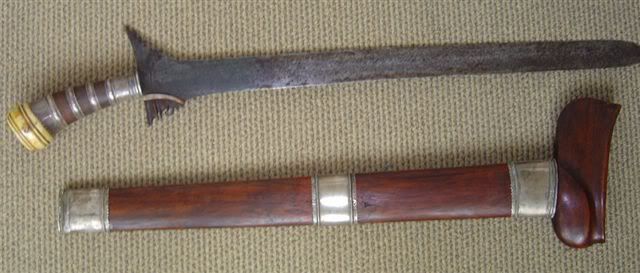 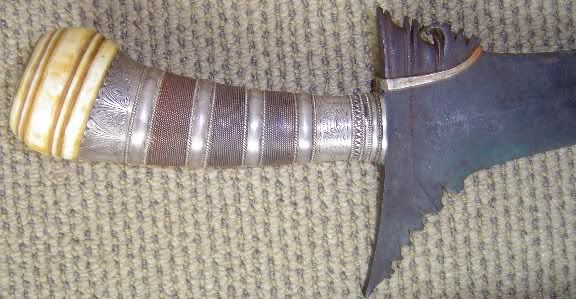 AND after conservation   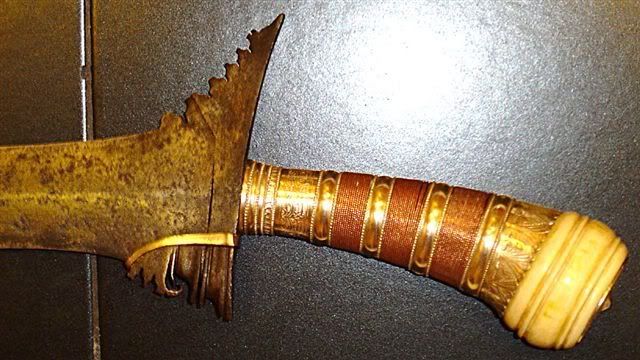 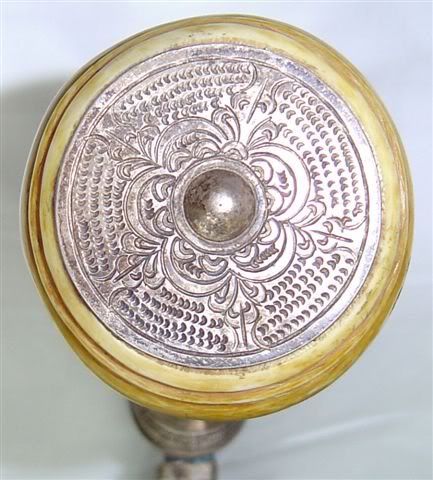 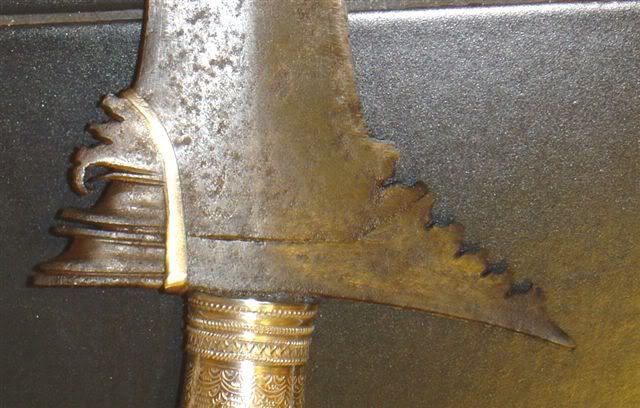  As a neophyte in Moro arms all comments are welcome. |
|
|

|
|
|
#2 |
|
Member
Join Date: Dec 2004
Location: Oahu, Hawaii
Posts: 166
|
And as I promised Ian you're gonna be famous!
The old stud himself (could hardly keep the ladies off him) 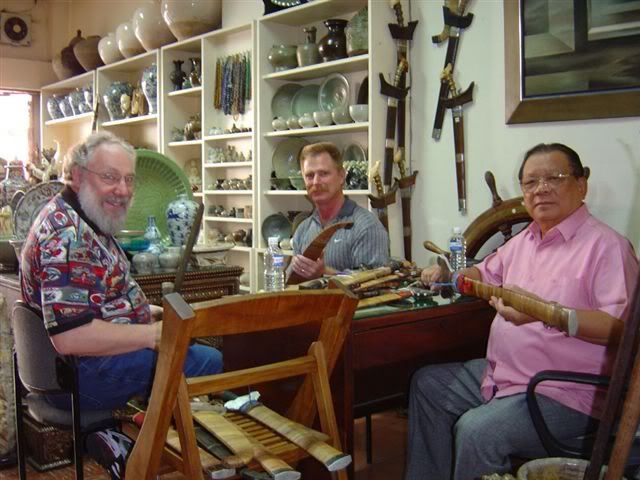
|
|
|

|
|
|
#3 |
|
Vikingsword Staff
Join Date: Nov 2004
Posts: 6,339
|
Welcome to the Kris fraternity Dan !
 Now get back to collecting those Daab Dha Darb thingies . If you can ... muahahahaha .   Seriously though , it looks like a pretty old Maranao blade that may have been re-hilted some 50 years ago . The dress is quite nice , very nice engraving but the baca baca would be too light for a Maranao battle sword IMHO . |
|
|

|
|
|
#4 |
|
Member
Join Date: Dec 2004
Location: Singapore
Posts: 1,180
|
Great catch!
 I am most fascinated by the greneng -- the 'Y' shaped incisions which I thought was rather unusual. I am most fascinated by the greneng -- the 'Y' shaped incisions which I thought was rather unusual.
|
|
|

|
|
|
#5 |
|
Member
Join Date: Dec 2004
Location: Witness Protection Program
Posts: 1,730
|
the artwork on the hilt is so....beautiful! i hope you left me some good ones. great kris, wilked! do you have some other ones that you might want to share with us?
|
|
|

|
|
|
#6 |
|
Member
Join Date: Dec 2004
Location: Cincinnati, OH
Posts: 940
|
I agree with Rick. This keris has been re-hilted with a rather nice looking piece at that and the sheath is also fairly new. My guess is that this was not a datu blade at all, but something more common place. It is obviously a pre-1930s style and likely 19thC, but IMO the workmanship is not up to datu class blades. It is not unusal for old blades like this to be spiced up with fancy dress to make them more appealing for sale. Still a nice looking kris that i would be happy to own.

|
|
|

|
|
|
#7 |
|
EAAF Staff
Join Date: Dec 2004
Location: Louisville, KY
Posts: 7,280
|
Welcome to the insane and confusing world of PI/Moro collecting.
 Nice piece. Yes it is a later dress than the blade. I agree more recent. Did you check to see if the fittings are silver or aluminum? The patination indicates silver to me, but a jeweler could test and tell you with certainty. Nice piece. Yes it is a later dress than the blade. I agree more recent. Did you check to see if the fittings are silver or aluminum? The patination indicates silver to me, but a jeweler could test and tell you with certainty. Ian is a wonderful man, informative, and very patient (I bow in your presence  ). ).
|
|
|

|
|
|
#8 |
|
Member
Join Date: Nov 2004
Location: USA
Posts: 1,725
|
[QUOTE=Rick]Welcome to the Kris fraternity Dan !
 Now get back to collecting those Daab Dha Darb thingies . If you can ... muahahahaha .   [QUOTE] I agree, Dan. Wanna sell some dha? 
|
|
|

|
|
|
#9 |
|
Member
Join Date: Dec 2004
Location: Minneapolis, MN, USA
Posts: 312
|
As others have noted the dressing is modern. It has become common practice in many Manila antique shops to dress-up older blades in modern fittings, and then try to "antique" the fittings. In some even trickier shops, they are now re-using old salvaged woods and other materials to give it an older look and color. Particularly in Maranao country, such as Tugaya, one can see a plethora of re-fitted old blades mixed in with newly made ones. I would be interested in what the shop owner had to say about the kris, whether or not he mentioned it as being a re-fit.
|
|
|

|
|
|
#10 |
|
EAAF Staff
Join Date: Dec 2004
Location: Louisville, KY
Posts: 7,280
|
Federico, what you have said may explain what I have been seeing on eBay for the past 2 years: old blades with new fittings with varying degrees of craftsmenship, but not in the old styles.
|
|
|

|
|
|
#11 |
|
Member
Join Date: Dec 2004
Location: VISAYAS and MINDANAO
Posts: 169
|
Refitting an old Moro blade is not uncommon since the blade is the heart of any sword. If the blade is really well made, it should outlast several dress changes. The dress on Dan's kris is well executed and not grossly overdone. I've seen some of those overdone krises (usually made for the tourist market) that are too gaudy to be considered serious weapons. I tend to agree with Rick that the redress of this sword was probably done around 50 years ago. More recent work tends to be gaudier and lower craftsmanship. It's still a nicely done sword. Good catch, Dan!
Now...are you going to tell us about that barong you're holding in the picture? |
|
|

|
|
|
#12 |
|
Member
Join Date: Dec 2004
Location: Minneapolis, MN, USA
Posts: 312
|
While traditional in use re-fitting is not un-heard of, I am suspicious of this piece being done older (50 years ago). Particularly due to the heavy attempt to age the fittings, blue glue (I just dont think blue glue would stay blue for fifty years, I would see it getting darker from ), and the blackened blade with live rust (generally the blades that get this treatment are in rough shape to highlight the age) and that Ive have seen this plainer fitting motif on newer pieces that I have been told were new. I also have my doubts about this blade being a good candidate for the owner to put such fittings. If it were traditional fittings, he is upgrading a battle blade with datu-esque fittings. Particularly after WWII, I am suspicious. If he is jumping up in rank, during the fifties I can think of other vestiges that would be more common.
I hate to say it, but while over-done pieces are easier to detect, those who try to pass of old as new are getting smarter and are realizing subtler construction is easier to pass off. There have been a number of pieces that Ive seen, and known were modern composites and was surprised at the sophistication they are starting to attain. |
|
|

|
|
|
#13 |
|
Member
Join Date: Dec 2004
Location: Houston, TX, USA
Posts: 1,254
|
Again, the focus in discussing re-hilting seems to focus on the concept of deception. Why? The focus in actual re-hilting is usually to provide one where there is none (or a very damaged one). In so doing the craft-man may take into account that a once ordinary item is now a valuable antique, and so its social status has been lifted, and a fancier dress than it would originally have worn may so seem appropriate. He will often use a style contemporary/familiar to himself. He will often try to give it an overall look and surface that matches the piece, rather than "leaping out" as a repair/replacement, so that it looks good, not so much to deceive(and when he doesn't imitate the old style, how serious can his suposed intent to decieve be?). Those who hire one to do repairs on thier noncommercial properties typically request this, BTW. I don't mean to be ethnically insensitive, but it's an education to watch the modern/American mind at work; everything is assumed to be about show and deception. In my opinion this often says more about that culture than about those it tries (usually unsuccessfully, IMHO) to anylize.
I have read that, in addition to smelling bad, social injustice, and cannibalism, differing cultures almost always find each other to be decievers; it seems peoples have different views on what constitutes honesty, and partly because of this (and partly because it's true, of course) tend to consider each other horribly dishonest. This concept has been penetrating my mind, as I try to deal with and comprehend those who suround me in this world. Last edited by tom hyle; 22nd January 2005 at 01:44 PM. |
|
|

|
|
|
#14 |
|
Member
Join Date: Dec 2004
Location: Oahu, Hawaii
Posts: 166
|
I am sure the redress was done quite some time ago and here's why. I've polished many a sword and this one took three applications to bring out the brilliance. While I agree that the actual setting of the blade may have been earlier than fifty years ago the dress shows definative age and undoubtably usage wear at exactly the points it should, index finger placement (the chasing is almost worn off there) and at heel of the hand. Many bands are seperated and lower ones remain tighly woven. The grime, especially that imbedded in the copper wire wrap, was especially difficult to remove and was not just dirt but oily grime that had set in over time. The ivory was particularrly hard to clean and is still embedded in the three cracks that show (I only showed the best side).
Zelbone, will post the Barung(s) tomorrow. Andrew, yes I do have some dha for sale - you can bid on them at my funeral after you pry them from my cold dead hands!!!! Your address was where in Florida and you're taking your vacation when? I have not turned, I've simply EXPANDED  I have limited my collection by two criteria either I've worked there or worked with their troops. Hell if I didn't I'd definately go broke especially with all those flambouyant Indian swords I love to look at. I have limited my collection by two criteria either I've worked there or worked with their troops. Hell if I didn't I'd definately go broke especially with all those flambouyant Indian swords I love to look at.Best to you all and thanks for the input. |
|
|

|
|
|
#15 |
|
Member
Join Date: Dec 2004
Location: Minneapolis, MN, USA
Posts: 312
|
Of course, I would not be surprised if the dress was 10 or 20 years old, when I implied newer than 50 years old, I did not mean it was made yesterday, or even the year before.. But I am suspicious when it comes to Manila Antique shops. While I would like to tell myself, oh it is a traditional upgrade of hilts. Ive seen and been told too many stories from "Manila Antique" shops telling me that they have a "Maranao Datu's piece" that "displays all the fine acruitriments of a wealthy persons sword such as ivory or silver or gold", etc... and above all it is all original. In this case the upgrade of hilts was not to repair a good ol piece that was missing a hilt, but an intentional upgrade to turn a common persons kris that would sell for a lower price, into a "Datu's" kris at a much higher price. Which is why I am interested in what the seller had to say. If he is open about it being a composite, then I am more inclined to believe I am being overly paranoid, but if instead he gives a lovely story about an original piece then I become much more skeptical about the "traditional" repair. Also, pusaka pieces are not lightly given in Moroland today. If indeed it was a traditional re-do, and the owner hit hard times, the owner would do his best to keep the blade. Moro royalty, the only ones for whom such a re-build would be proper (the jump in stature for a commoner, even a rich commoner would be a very bad slip in social etiquite) are very much aware of how their ancestors were robbed of fine pieces on the field of battle, and many if not all are very protective of what few cultural heirlooms they have left. Which leads to then, why get rid of such a fine piece, after taking so much time and money to get it re-done so well, when there would at least be a few options around it? Now of course we can get into the role of the MNLF fighting in the 70s, a time when many fighters did sell pieces in dire straights, but stuff sold in this period, since the MNLF was largely a common persons movement, and not overly filled with royalty (many of whom were entrenched in official government) were plainer less guady swords. Now, current groups have other means of raising capital, and straights arent so dire. Which leads us back to why sell the pusaka?
|
|
|

|
|
|
#16 |
|
Member
Join Date: Dec 2004
Location: Witness Protection Program
Posts: 1,730
|
well, there's also the possibility of those swords being looted items (by p.i. soldiers) or stolen items. i know manila is notorious for such a thing as you mentioned, but not everyone's crooked over there, bro. there are just too many variables...
|
|
|

|
|
|
#17 |
|
Member
Join Date: Dec 2004
Location: Singapore
Posts: 1,180
|
Just an idea -- the assumption that owner of a high status blade would only sell it during hard times -- but what if its a case of the current generation being disinterested in his 'grandfather's dusty old stuff' and have no qualms selling it off to buy a car, rolex or handphone?
|
|
|

|
|
|
#18 |
|
Member
Join Date: Dec 2004
Location: Singapore
Posts: 1,180
|
And just another idea -- I'm not sure about how Moros normally get elevated in social standing to the status of a Datu, but if it is possible that a person 'fights' his way up social hierarchy to become a Datu, he and his descendants may keep the trusty old blade that accompanied (and contributed to) the person's rise and simply change the dress to fit the elevated social status. Of course, the person may also commission a new blade.
|
|
|

|
|
|
#19 |
|
Member
Join Date: Dec 2004
Location: zamboanga city, philippines
Posts: 132
|
just my 2 cents worth... a pusaka is sometimes offered for sale if the owner intends to get something greater in return. example, the money can be used to fund a hajj to mecca.
in other instances it maybe a swap for a modern weapon - 1911 gold cup or better still a baby armalite. |
|
|

|
|
|
#20 |
|
Member
Join Date: Dec 2004
Location: Minneapolis, MN, USA
Posts: 312
|
Elevation to Datu class would be through marriage, while one can rise to high status otherwise, Datu class is royalty class. Kinda the same idea, no matter how rich Trump gets, he is still not a royal unless he marries into it. Now it has happened that people of common origins have improved their blood lines through marriage, but to do this, one needs quite substantial bits of money. Now, I did not mention the potential for stealing items, because I would like to hope things arent this way in this situation, but I am afraid it is far too common. Particularly in the santo trade, an amazing amount of churches have been robbed to provide collectors markets in Manila. However, I would not like to cast such extreme allegations without specific proof.
As for pride in the past heritage going down, or trading for a new weapon, large sum of money, etc... It happens, all the time. However, again we are looking at what would be a very high class weapon. Ivory, and metal hilted pieces are not exactly commonplace. The amount of those in the Datu class who joined the MNLF, MILF, and other rebel groups has been very low. PI is a poor country, but not everyone in PI is so poor that they are willing to sell their lives at a whim. I am not trying to be overly harsh here, but realistically the number of truly legitimate high end pieces left in the PI after the glut of the Spanish American war is very very low. The high end pieces left, were those in the possessions of people who were not exactly low end ranking royalty, and who are very much concerned with preserving their cultural history. On a numbers level, the amount of people in the class to make such a change, remain very low. We are talking major calamities and great change of fortune here for things to change around. Also considering the age of the re-fit, it is very likely that the person who sold it, was alive when the refit was done, limiting the idea of the grandkid an the grandpas chest. Now on the flip side, the numbers of old commoner blades being re-habbed and then sold as royal weaponry, are quite high and have been a well documented process for many many years. There are fakes in every other sword market, many with high degrees of sophistication. So just because PI is a poor country, we are supposed to buy the idea that fakery wont occur? Are we supposed to buy, that only the guadiest tourist items are the only items being passed off as real? While here in the US because of the rampant nature of stripping dead bodies during the Phil-Am war, and the lower value the general populace has for these weapons, people of relatively humble backgrounds, such as I can afford to have a few pieces. However, in PI it is names like Zobel, Araneta, Alaya,etc... that collect these pieces. The prices that have been paid for plainer pieces in Manila markets for such collectors, has been extremely high. Now, are we to assume that there would not be someone out there who wouldnt want to put a little extra effort to tap into a few of these dollars beyond bringing out the guadiest of tourist kris of the type that one finds in shoemart? Is PI full of saints? OK, I am not trying to say one cant collect what one wants, and that only 100% original is great. My own collection is all what many would consider junky pieces, that have been re-habbed numerous times. I can only think of a few pieces that are somewhat complete, and I dont think I have anything that is 100% original. I am trying to say exercise some caution this stuff happens, and sometimes when it sounds too good to be true, well... As before I am interested in hearing the story behind the sword. As I mentioned before, I am more inclined to be less paranoid if the dealer isnt trying to pass it off as 100% original, when we can all see it is not. But given the state of things, I wonder, and hence I express my curiosity about the origins and stories of this sword, and throw out the caution to those who have not experienced the fact that fakes are occuring in such a nature, that hey its nice, well done, but it is not old or probably royal. For me the greatest tragedy, is that a number of swords that do get re-habbed like this were suitable working swords, but lacked the sex-appeal of a fancy piece. |
|
|

|
|
|
#21 |
|
Member
Join Date: Dec 2004
Location: Oahu, Hawaii
Posts: 166
|
Frederico, completely understand your outlook. I had many of the same questions, which is why I put the ? after Datu to hopefully bring out this type of information. Ian has been dealing with this particular dealer for 10 years. He was blatantly honest about all the pieces he showed us pointing out flaws and newly made stuff. This sword was produced from the back room sometime into the visit and wasn't out for show. What he did tell us is that he must keep cash on hand as sellers come through intermittenly from down south and he has only one shot at the buy (cash only) and then they move on. This is how he acquired this one, someone came up from down south with several pieces and this was one of them. He said he usually keeps these in the back for his banker trade as they and doctors are apparently his best clientele. That's all I know.
I had also heard that rising to Datu class could only be achieved through marrage for you needed to trace your bloodlines back to the first Sultan who was believed to be a direct descent of (Suileman or was it Mohammed), however I thought there were some who also got it from amassing wealth? As to could it have been stolen, honestly a question I'd rather not know, as I am to this day already somewhat conflicted about the posssibility of being accused of stealing someone else's national heritage. Zamboanga brings up an excellent point (and he should know he's in the middle of it). The Colt and the M4 (M16 carbine version) are now the "status" pieces that the swords used to be. This is one of the ways to quickly identify which one in the troop is the Commander and with a raise in rank it is not unusual for an individual to seek any means to exhibit his new status. As for there not being many Datu class in the MNLF (reorganized as the MILF several years ago when they set up the Autonomous Region of Muslim Mindanao) Everyone is related to each other in some shape or form and it is all too commonplace for the Governors, Mayors, and political elite to be espousing the government position verbally and then helping out their relations in those organizations in anyway they can that can't be traced. It really is all about relationships in this country - which is NOT a bad thing just something to be aware of . Spunjer and BluErf, your comments also are both right on as I understand the current situation. Thanks for all the input guys. |
|
|

|
|
|
#22 |
|
Member
Join Date: Dec 2004
Location: Houston, TX, USA
Posts: 1,254
|
With enough money, it's usually possible to come up with pretty much whatever research and whatever results you want, genetic or otherwise.
I personally believe that, at least in most nations (Australians make a possible notable exception, for instance, having perhaps never had kings over them before a couple hundred years ago, and conspicuously foreign ones then.), every human is descended of slaves and of kings. Likewise, everthing has been in some sense, at some point, stolen, and you must decide, I guess where the line accrues; we all steal life just to eat. We live on stolen land, bought in blood. All of us. Those who rent may still feel a twinge, if they think too much. How far back do you want to go? The Latins used to have a saying about the concept of "dirty money". "Money doesn't stink," they said. I have mixed feelings about the concept that buying antiques (as contrasted to literally stealing them) constitutes an assault upon the seller's cultural heritage. I must say that it is VASTLY my observation on the worldwide antique scene that the source of the majority of old stuff on the market (granted, this is slanted by it being stuff I can afford, but I have not found that tightly bounded by quality or even fanciness) is people for whom it is old junk they do not respect and do not want. And yes, I've acquired rusty old "junk" as junk, at junk prices, coming out of ancestor-worshipping central Africa, as well as Indonesia and PI. And yes, it was good stuff. Don't get me wrong; theives suck; Oh, I've been stolen from  but it's an awful complicated ethical issue when you really think about it, and drawing the line may not be as simple as it seems. but it's an awful complicated ethical issue when you really think about it, and drawing the line may not be as simple as it seems.
|
|
|

|
|
|
#23 |
|
Vikingsword Staff
Join Date: Dec 2004
Location: The Aussie Bush
Posts: 4,396
|
Sorry to come in a little late on this one. Traveling again. Dan and I had a lot of fun doing the rounds in Manila a few weeks ago.
As Dan has said, this sword came from one of Manila's best edged weapon dealers with whom I have dealt for many years. Mr Ven had obtained it only a few days before we went to his shop, and this one came from the back room where he puts away expensive pieces for his local and international clients who can afford the better class items he finds. Having handled this one, I am sure that the blade is 100+ years old. It has a separate gangya and a dark patina with no pitting, although a little active rust on the gangya (probably related to recent storage). The edge was straight and showed no dings or evidence of extensive wear/sharpening. Balance was good, and the blade felt lively despite being of quite heavy construction. The pommel is old ivory, with prominent linear age cracks and a nice golden patina, and the silver appears to be older work also with wear from handling (as Dan stated). The scabbard is probably a replacement, but a nicely made one none the less. Simple, well carved, nice dark patina to the wood, and silver fittings (or at least silver-plated). This is better than the recent work coming out of Mindanao, and looks circa WWII to me based on other examples I have that were well provenanced. So I think Dan has acquired a nice Maranao kris with blade and hilt c. 1900 and scabbard perhaps somewhat later. Whether datu quality is hard to say. Certainly, much better than average in terms of the quality of fittings on the hilt. The dealer also felt the blade was around 100 years old, but the scabbard was not as old. Ian. |
|
|

|
|
|
#24 |
|
Member
Join Date: Dec 2004
Location: Minneapolis, MN, USA
Posts: 312
|
Datu class can be bought in a round about way. A prime example was Datu Piang, or Datu Pedro around the turn of the century. Though more pronounced in the case of Datu Piang, who was the child of a slave. With enough wealth, particularly Datu Piang, he improved his own standing through marriage, and then subsequently improved his children's standing through arranging upward marriages for them. The role of wealth really comes out through dowry prices. Poor datus need money, marriage to rich people becomes a win win situation.
As for backwards channels of money, shabu, kidnappings, and smuggling are very good ways to make money these days that are not as traceable as selling ones family heirlooms. I am Pilipino, and very much aware how family connections work in PI. But at a certain extent, things die down the further away one is related. A seventh cousin, five times removed may be able to get a few bucks from a richer relative, but to sell ones family heirloom, particularly if one still follows old traditions? Moroland would not be in as such dire straits if people were truly that magnaminous, yet one hears all the time of Muslim brothers living in Manila ghettos. I know I can only give so much to poor relations, and at a certain point, with my own child to feed it does become a question of the fact that you are still only my seventh cousin five times removed. Utang na loob, is not some mysterious blood debt as some Westerners would have it described, and while has meanings, is often not as strong as some would believe. I know a good test is at funerals. When my own father died, I watched who truly paid back their debts through their respects, and who were false and did not. Unfortunately, the number who were false, and knew only how to ask was quite high. Chismis and lipservices is just as common as Utang, though not paying attention to utang will destroy what little chance you have to move forward. Anyways, as I stated before, old blades in newer made fittings, which in turn are made of older materials (eg. old ivory or wood), are becoming more and more common. These are the blades targetted towards the doctors, lawyers, and those with money, and have been popping up more and more in recent years. These are the trickiest pieces, and as with all the debate this piece is pulling up, are the most difficult to detect. I am glad to hear there was not a story put along with the blade. In itself it is great quality work, which is a testament ot Mr. Ven's integrity, as many other dealers will give a story. And in itself has quality that is inate. My primary concern is knowledge that, A. it is not completely original and B. many out there will use the upgrade as a selling point. Almost all the dealers in antiques in PI, have a similar story. An old Moro comes around, and that's how they buy their swords. For the vast majority of them it is not safe to go deep into Moroland. But there are some who do, it is from those I have heard and seen pictures of these pieces being cobbled together. It is from other collectors that who have seen people tear apart old pieces, re-hilt them, age them, and then pass them off as original that makes me wary. Hence my little warning, that the practice occurs. Now with rapid turnover, and the precarious nature of dealing, I can understand that stuff creeps in, even amongst the most honest, hence the need to be always alert. |
|
|

|
|
|
#25 | |
|
Member
Join Date: Dec 2004
Posts: 751
|
Quote:
THANKS |
|
|
|

|
|
|
#26 |
|
Member
Join Date: Dec 2004
Location: Oahu, Hawaii
Posts: 166
|
Carlos, It's in Manila about three blocks from the US embassy. Smack in the middle of a nightlife district.
|
|
|

|
|
|
#27 |
|
Member
Join Date: Dec 2004
Posts: 751
|
THANKS FOR THE INFORMATION, I´M THINKING TO CHANGE MY PLACE OF HOLIDAYS!!
|
|
|

|
 |
|
|